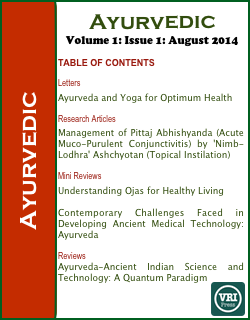
Contemporary Challenges in Ayurveda: an Ancient Medical Technology
Abstract
Ayurveda is an indigenous traditional medical technology of India that remained as a dormant medical system for the past few thousand years. Recently, mainstream medical system has probed into this Ancient Technique to demystify the mechanism of operation and examine its scientific validity. There are a number of issues that one comes across in such a venture which are addressed in this review. However, a paradigm model using a modern framework is suggested to be the best approach due to the nature of its axiomatic construct compared to its modern counterpart. This review addresses the shortcomings and advantages of the development of Ayurveda along with contemporary mainstream medical science.
Â
Keywords
References
Keswani NH: Medical heritage of India, In The Science of Medicine & Physiological Concepts in Ancient & Medieval India, All India Institute of Medical Sciences, New Delhi, 3-49; 1974.
Sinha N: The Samkhya Philosophy, Oriental Books Reprint Corporation, New Delhi, i-xv, 1979.
Verma RL, Keswani NH: Unani medicine in medieval India-Its teachers and texts, In The Science of Medicine & Physiological Concepts in Ancient & Medieval India, All India Institute of Medical Sciences, New Delhi, 127-142, 1974.
Pillai TVS: Tamil-English Dictionary of Medicine, Chemistry, Botany and Allies Sciences, The Research Institute of Siddhar’s Science, Madras, India, 1-114, 1931.
Krishnamurthy KH: Botanical identification of ayurvedic medicinal plants: A new method of pharmacolinguistics. Ind. J. Med. Res. 59, 90-103, 1971.
Pillai NG: On the botanical identity of Sankhapushpi, J. Res. Ind. Med. Yoga & Homoeo.11,67-76, 1976.
Sharma PV: Vopadeva’s Hrdayadipaka nighantu and Siddhamantra of Vaidyacarya Kesava, Chaukhamba Amarabharati Prakashan, Varanasi, 1- 44, 1977.
Sharma RK, Dash B: Caraka Samhita, Vol. 2, Chowkhamba Sanskrit Series Office, Varanasi, 215-256, 1985.
Lakshmanan S: Highlights of a Proposal Submitted to the Government of India and World leaders for building Ancient Science and Technology and bridging the gap with Modern Science. Ancient Science 1(2), 30-35.
Prabhakar YS, Kumar DS: A model to quantify disease state based on the ayurvedic concept of tridosa. J. Bull. Ind. Inst. Hist. Med. 23, 1-19, 1993.
Kumar DS, Prabhakar YS: On the ethnomedical significance of the Arjun tree, Terminalia arjuna (Roxb.) Wight & Arnot. J. Ethnopharmacol. 20, 173-190, 1987.
Prabhakar YS, Kumar DS: The chemistry of Terminalia arjuna (Roxb.) Wight & Arnot with reference to its medicinal uses. Plantes Médicinales et Phytothérapie 22, 30-39, 1988.
Prabhakar YS, Kumar DS: The Varuna tree, Crataeva nurvala, a promising plant in the treatment of urinary stones - A review. Fitoterapia 61, 99-111, 1990.
Upadhyaya Y: Astangahrdaya, Chaukhamba Sanskrit Sansthan, Varanasi, 90-96, 1975.
Athavale AD: Astangasamgraha, Srimad Atreya Prakashan, Pune, India, 95-101, 1980.
Friend DR, Chang GW: A colon-specific drug delivery system based on drug glycosides and the glycosidases of colonic bacteria. J. Med. Chem. 28, 261-266, 1984.
Friend DR, Chang GW: Drug glycosides: potential prodrugs for colon-specific drug delivery. J. Med. Chem. 28, 51-57, 1985.
Vyas M: Report of the Assessment Committee for Research and Post-Graduate Studies, Gujarat Ayurveda University, Jamnagar, India, 1-83, 1969.
Meindersma TE: Interpreting and evaluating texts and practice from the point of view of Western medicine, In Proc. International Workshop in Priorities in the Study of Indian Medicine, Rijksuniversiteit te Groningen, Groningen, 167-185, 1984.
DOI: http://dx.doi.org/10.14259%2Fav.v1i1.158
Refbacks
- There are currently no refbacks.










